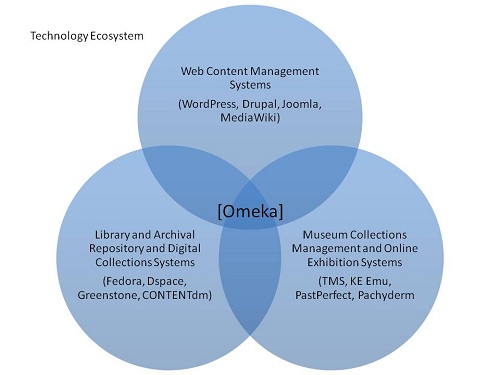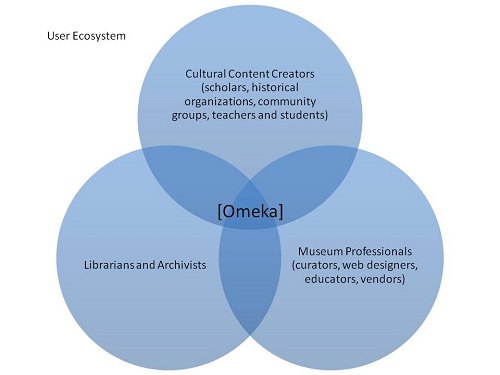As an open source, not-for-profit, warm-and-fuzzy, community service oriented project, we don’t normally like to talk about market rivals or competitive products when we talk about Omeka. Nevertheless, we are often asked to compare Omeka with other products. “Who’s Omeka’s competition?” is a fairly frequent question. Like many FAQs, there is an easy answer and a more complicated one.
The easy answer is there is no competition. ;-) Omeka’s mix of ease of use, focus on presentation and narrative exhibition, adherence to standards, accommodation for library, museum, and academic users, open source license, open code flexibility, and low ($0) price tag really make it one of a kind. If you are a librarian, archivist, museum professional, or scholar who wants a free, open, relatively simple platform for building a compelling online exhibition, there really isn’t any alternative.
The more complicated answer is that there are lots of products on the market that do one or some of the things Omeka does. The emergence of the web has brought scholars and librarians, archivists, and museum professionals into increasingly closer contact and conversation as humanists are required to think differently and more deeply about the nature of information and librarians are required to play an ever more public role online. Yet these groups’ respective tool sets have remained largely separate. Library and archives professionals operate in a world of institutional repositories (Fedora, DSpace), integrated library systems (Evergreen, Ex Libris), and digital collections systems (CONTENTdm, Greenstone). Museum professionals operate in a world of collections management systems (TMS, KE Emu, PastPerfect) and online exhibition packages (Pachyderm, eMuseum). The humanist or interpretive professional’s online tool set is usually based around an off-the-rack web content management system such as WordPress (for blogs), MediaWiki (for wikis), or Drupal (for community sites). Alas, even today too much of this front facing work is still being done in Microsoft Publisher.
The collections professional’s tools are excellent for preserving digital collections, maintaining standardized metadata, and providing discovery services. They are less effective when it comes to exhibiting collections or providing the rich visual and interpretive context today’s web users expect. They are also often difficult to deploy and expensive to maintain. The blogs, wikis, and off-the-rack content management systems of the humanist (and, indeed, of the public programs staff within collecting institutions, especially museums) are the opposite: bad at handling collections and standardized metadata, good at building engaging experiences, and relatively simple and inexpensive to deploy and maintain.
Omeka aims to fill this gap by providing a collections-focused web publishing platform that offers both rigorous adherence to standards and interoperability with the collections professional’s toolkit and the design flexibility, interpretive opportunities, and ease of use of popular web authoring tools.
[Figure 1. Omeka Technology Ecosystem]
By combining these functions, Omeka helps advance collaboration of many sorts: between collections professionals and interpretive professionals, between collecting institutions and scholars, between a “back of the house” and “front of the house” staff, and so on.
[Figure 2. Omeka User Ecosystem]
In doing so, Omeka also helps advance the convergence and communication between librarians, archivists, museum professionals, and scholars that the digital age has sparked, allowing LAM professionals to participate more fully in the scholarship of the humanities and humanists to bring sophisticated information management techniques to their scholarship.
Which brings us back to the short answer. There really is no competition.
[Crossposted from Found History]

